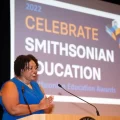Using a museum’s approach in the classroom
Object-based learning is a tool that any educator can use, no matter what subject they teach.
![]() The National Air and Space Museum has thousands of objects that celebrate the history of aviation and space flight. From moon rocks and spacesuits to rocket planes and kites, our objects tell stories of ingenuity and perseverance. Teaching with objects doesn’t just happen in the museum. Object-based learning is a tool that any educator can use, no matter what subject they teach.
The National Air and Space Museum has thousands of objects that celebrate the history of aviation and space flight. From moon rocks and spacesuits to rocket planes and kites, our objects tell stories of ingenuity and perseverance. Teaching with objects doesn’t just happen in the museum. Object-based learning is a tool that any educator can use, no matter what subject they teach.
As an educator at the National Air and Space Museum, I work to support teachers in transferring these ideas to their own classrooms.
Why use object-based learning?
One of the questions that I hear often from teachers is “Why should I incorporate objects in my classroom?” If active teaching is the goal, there is no better approach than to use objects. Objects are a tangible representation of concepts that can spark curiosity, make connections to abstract ideas, develop skills, extend knowledge and encourage close looking and examination. In addition, close looking at objects requires no particular content expertise, leveling the playing field for learners of all types.
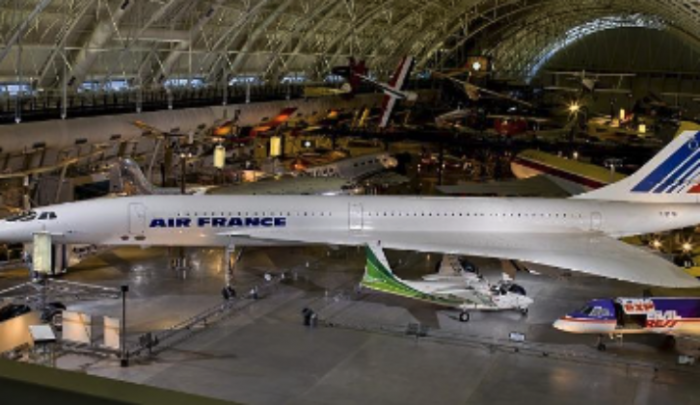
(Image credit: National Air and Space Museum)
While museums are amazing places to visit to examine objects with students, they are not the only learning environment where this type of learning can take place. Take, for example, the drawer of an old sewing machine or the science department storage closet that has not been emptied in decades. These spaces provide teachers with a wide range of interesting objects to examine with their students.
Looking at an object for the first time helps learners build reasoning skills and provide evidence. A student may look at the Air France Concorde and say that it looks fast, which is certainly true. More importantly, it creates an invitation to deepen the examination and a check for understanding that comes from asking, “What makes you say that?” Not only do learners then have to put their ideas into words, but it gives the opportunity for other students to offer supporting evidence for the claim, or even refute it. The richness of discussion and the lively debate that follows is often not possible when simply discussing a concept with words and text.
Object-based learning can also provide a springboard into a unit of study. Consider the different hooks to a unit on space exploration. A teacher might ask students what they know about space, eliciting answers both true and false and on topic and off the intended scope of learning. Alternatively, they might visit a museum and see (or use an image or 3D print) a flown spacesuit.
Asking what questions they have about a specific object anchors the idea in something physical, allowing them to make connections to something they can examine, and likely ask deeper questions.
In the classroom, the start to a unit about ecosystems could begin with an analysis of owl pellets or an animal skull, giving students an opportunity to examine something real to help formulate questions. To wrap up a unit and assess understanding, students could create their own exhibition with authentic or created objects to put it all together.
Using objects in real classrooms
The Teacher Innovator Institute at the National Air and Space Museum is a professional development intensive for middle-school STEAM teachers across the US. Since 2018, over 120 teachers have been a part of the program, which seeks to help bridge the gap between the classroom and informal learning spaces like museums. One of the institute’s goals is to equip teachers with the tools of the museum educator, grounding them in the object-based learning and inquiry methods that are so successful in museum programs.
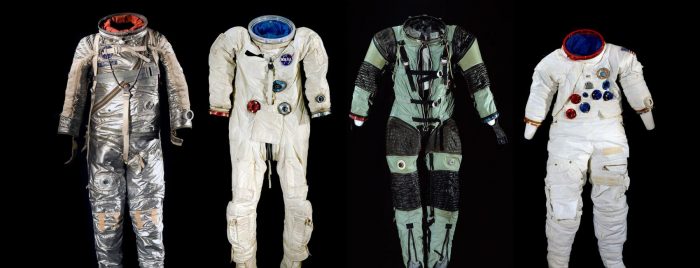
Spacesuits worn by astronauts dating from the 1960s to today. (Image courtesy National Air and Space Museum)
Melissa, a middle-school STEM and product design teacher from Texas, turned an institute webinar on teaching with objects into an introductory unit for the school year, with the goals of building rapport with students and instilling the foundational skills of close looking that she continues to use throughout the school year.
Students analyze a can of Coca-Cola (a classic object exploration exercise used across museum education programs) and are challenged to observe the object only, rather than applying their background knowledge about the content of the can or the company that makes it. They talk about the importance of background knowledge when examining new things, but also about the biases and stereotypes that previous experiences can bring into their learning. They use these same analysis skills to examine Melissa’s desk and gather clues about her as a person and a teacher, building classroom community and camaraderie.
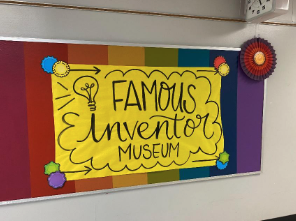
(Photo courtesy Linda Frantz)
Linda, a STEM specialist from Oklahoma, took the idea of the desk drawer and turned it into a dent-led exercise. As they studied STEM professionals and famous scientists, engineers and pioneers, Linda’s students were encouraged to create a collection of objects that their individual might have.
The students first used photos of their teachers’ desk drawers to practice. They then did a whole class activity of creating a desk drawer for a popular cartoon character, modeling together how they could think about what objects help someone do their job or tell their stories. Finally, they used pizza boxes and craft materials to create a drawer for a famous inventor and did a museum walk to share with their classmates and community.
Fifth-grade physical science teacher Lisa lets her students cut up onions in class to learn about the behavior of gasses, and high school STEM teacher Trevor has his students look at mission patches from various space programs to learn about symbolism and the different types of objectives for space missions throughout history.
Teacher feedback from these experiences described students who were actively engaged and having lightbulb moments as they worked together to formulate questions and think about possible solutions. With just simple household objects in most cases, students of all backgrounds and abilities made connections to concepts that would previously have been taught using slide decks and textbooks.
Student impacts
A small sample of students has been studied each year for the last three school years to determine if their teachers’ participation in the Teacher Innovator Institute impacted their engagement with STEAM concepts. Not only did over 80% of students rate their Institute-trained teacher as better than previous STEAM teachers.
More importantly, their attitudes toward STEAM learning changed for the better. Statistically significant increases were observed in “STEAM fascination” and “competency beliefs” categories. These categories indicate which students enjoy STEAM activities, are eager to talk about their learning with others and are excited about mastering new skills — as well as students who can see themselves as being successful at tackling new STEAM challenges.
Considerations for museum and school partnerships
In 2022, I had the opportunity to host an online panel at the Smithsonian National Education Summit featuring Institute teacher alumni. In the archived session, you can hear about an integrated unit designed by teachers that features PocketLab experiments and a Smithsonian Learning Lab collection, as well as models of the Guided Inquiry Design framework they used.
Museums like the National Air and Space Museum have the ability to reach millions of school-age visitors each year — but they can reach even more through teacher professional development programs that not only teach STEAM content but leverage objects and constructivist teaching techniques to make concepts accessible to all types of learners. Equipping teachers with the ability to teach any content through the lens of objects and inquiry broadens our reach beyond just the teachers who teach aviation and spaceflight-related subjects, allowing the museum to impact students of all types and increase their attitudes and aptitudes in STEAM.
____________________________________________________________________
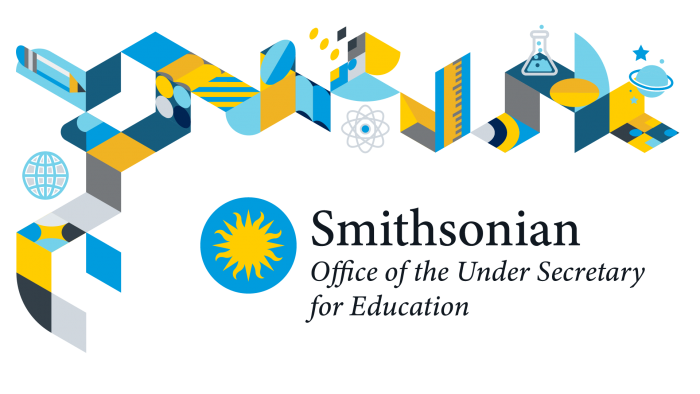
Welcome to Voice of the Educator, an ongoing series of posts by Smithsonian staff on hot topics in education, sponsored by the Office of the Under Secretary for Education and originally published by SmartBrief, which publishes more than 250 industry-focused newsletters.

Sharon Balfioli
Shannon Baldioli coordinates the National Air and Space Museum Education Department’s teacher professional development efforts. She is a former classroom teacher who transitioned to museum education after teaching in northeast Ohio. She is passionate about object-based learning, empowering teachers and students, and making programs and exhibitions accessible to all audiences.
Posted: 23 October 2023
-
Categories:
Collaboration , Education, Access & Outreach , Feature Stories , SmartBrief for Education


